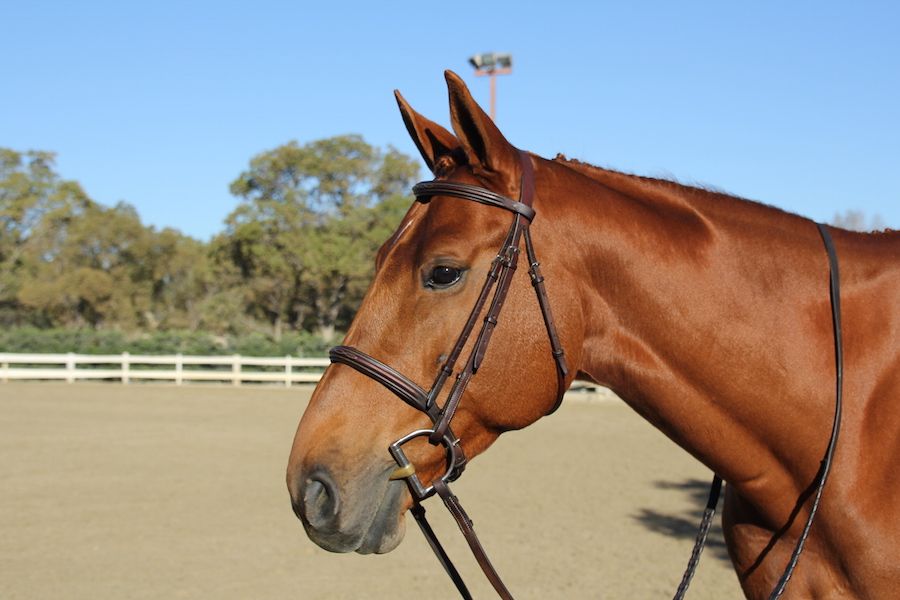
Eye surgery of Derrick the horse inspires children’s book, funds research
As majestic as they appear, horses are susceptible to many of the same illnesses and diseases that affect humans. One particular horse, Derrick, was treated by the UC Davis Veterinary Hospital after he developed cataracts and gradually began to lose his vision. For a horsed skilled in jumping, this condition was an enormous detriment.
“A cataract is an opacity of the lens which can be small or occupy the entire lens, causing blindness,” said Kelly Knickelbein, an intern in the Department of Ophthalmology at UC Davis. “Horses can develop cataracts for numerous reasons, such as trauma, having a genetic predisposition, a developmental abnormality or, most commonly, secondary to the intraocular inflammation, as was suspected in Derrick’s case.”
Initially, cyclosporine implants were inserted into Derrick’s eyes to minimize the flare ups of Equine Recurrent Uveitis (ERU). ERU, the leading cause of blindness in horses, is a chronic condition in which there is episodic inflammation of the uveal tract of the eye.
“Cyclosporine doesn’t treat cataracts directly — because the only treatment for cataracts is surgery — but may slow down progression of cataracts by reducing the frequency and severity of flare-ups of uveitis,” said Dr. Mary Lassaline of the UC Davis School of Veterinary Medicine. “The cataract can develop secondary to these inflammatory changes that horses have when they have ERU.”
After the implants were inserted, Derrick went on to perform several shows as a hunter-jumper with vision in only his left eye. However, the looming threat of cataracts quickly re-emerged.
Derrik’s owner, Terri Herrera, was fearful that Derrick would harm himself and other horses, or have a degraded quality of life due to blindness. With those outcomes in consideration, Herrera decided that euthanization may be the best option.
“I did not want [Derrick] to be in pain or in fear,” Herrera said. “When horses are afraid, they want to run. And if he doesn’t have vision, he could hurt himself or others.”
Lassaline was the veterinarian Herrera turned to for advice in Derrick’s deteriorating condition. When Herrera informed Lassaline on her decision to euthanize Derrick, Lassaline proposed the life-saving option of cataract surgery.
“The best candidates for cataract surgery are individuals that have cataracts that arise due to an abnormality in the lens itself, not cataracts that are secondary or caused by an underlying inflammatory disease such as ERU,” Lassaline said. “However, horses with cataracts secondary to ERU can still have successful outcomes — but their inflammatory disease can flare up when they have surgery.”
Though Derrick was confirmed to be a high-risk candidate for the surgery due to his pre-existing ERU, Herrera didn’t give up without a fight. After agreeing to the surgery, she stayed tirelessly by Derrick’s side as he underwent the complicated operation.
Despite the constant diligence of Lassaline and her staff, the surgery couldn’t sustain Derrick’s vision. Though Derrick eventually lost his vision, Herrera gained sight of a different purpose: to uphold the message that a horse has both the capacity and the right to live after blindness.
“Blindness doesn’t have to mean death for horses,” Lassaline said. “Many of them are able to adjust to life as blind horses, and some of them are even able to go on and continue to perform.”
Though how horses react to blindness varies and is dependent upon the horse, time is a critical healer in this process. Recovery usually takes a few weeks to a few months, but eventually horses become accustomed to vision loss and resume life normally.
As a part of his new life purpose, Derrick is the inspiration for Herrera’s children’s book, Derrick the Jumping Horse Has Eye Surgery. All proceeds from the book will be donated to the Equine Ophthalmology Service and to research focused on uveitis, eye problems, in children.
“The people that thought that the surgery wasn’t a success may be looking through the lens of science,” Herrera said. “But the reality is that there is a much greater purpose than what the eye can see.”
Written by: Harnoor Gill — science@theaggie.org



